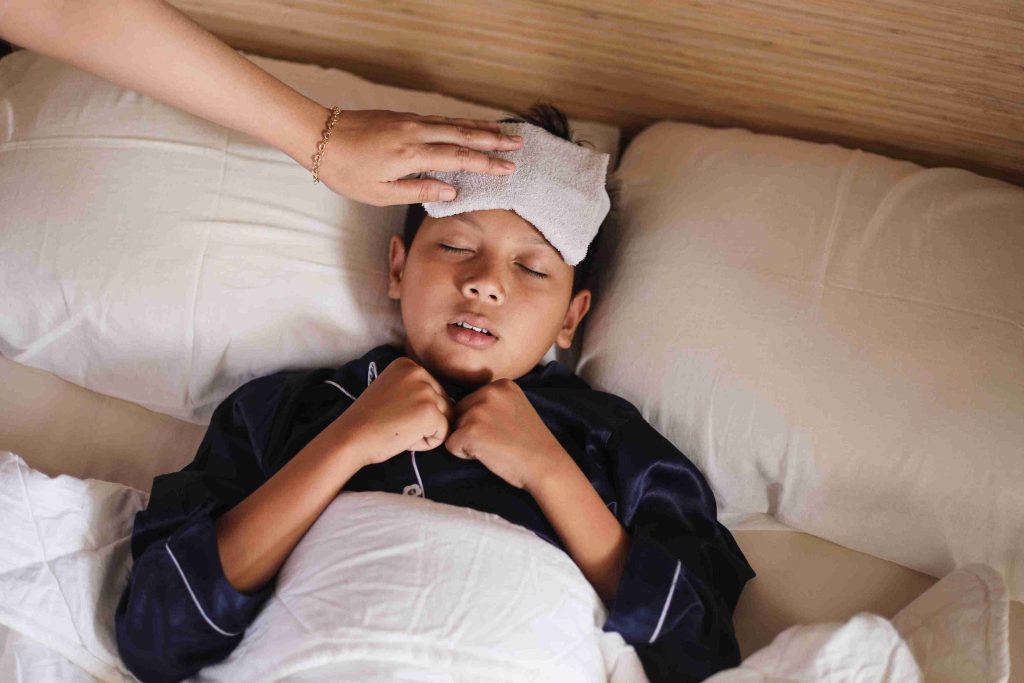Medically Reviewed by Dr Simone Quek (M.B.B.S. Singapore)
Fever is one of the most common reasons parents seek medical advice for their children. As a natural response of the body to infection, fever plays a critical role in defending against illness. However, despite its frequency and importance, fever often leads to confusion and concern among parents.
Misunderstandings about fever, especially in children, can lead to unnecessary worry or inappropriate treatment. This article will address and debunk common myths about children’s fever, providing clarity and guidance to ensure better care for your little ones.
What is a Fever in Children?
A fever is defined as a body temperature that exceeds the normal range, typically above 100.4°F (38°C). It is usually a symptom of an underlying condition, most often an infection caused by viruses or bacteria. In children, fevers are common and usually not a cause for concern.
The body’s immune system raises the temperature to help fight off infections, as many harmful organisms have a harder time surviving in a hotter environment.
However, many parents find themselves anxious when their child runs a fever, often driven by myths or misconceptions. It’s important to differentiate between fact and fiction when it comes to managing children’s fever.
Myth #1: A High Fever Can Cause Brain Damage
One of the most widespread myths about fever is that a high fever can cause brain damage or other long-term health issues. In reality, while a very high fever (over 106°F or 41°C) can be dangerous and may lead to seizures, it is uncommon. The body’s natural defense mechanism regulates temperature to prevent it from going too high.
Most fevers in children are not dangerous and typically fall within a manageable range (100.4°F to 102°F or 38°C to 39°C). As long as the child is comfortable and not experiencing signs of severe illness, such as persistent vomiting, trouble breathing, or extreme lethargy, a fever is usually not a cause for panic.
What Parents Can Do
If your child has a fever, monitor their temperature and overall behavior. Offer fluids to keep them hydrated, dress them in lightweight clothing, and keep the room cool. If the fever rises above 102°F (39°C), you can give them age-appropriate fever-reducing medications like acetaminophen or ibuprofen, but always follow the dosage guidelines carefully.
Myth #2: You Should Never Let a Child’s Fever Run Its Course
Some parents believe that a fever should always be treated immediately to bring the temperature down. However, fever itself is not harmful; it’s often a sign that the body is fighting an infection.
What Parents Can Do
It’s important to focus on making your child comfortable during a fever, rather than rushing to reduce it. Providing hydration and rest is key. If the child seems distressed or uncomfortable, you can use fever-reducing medications or offer a lukewarm bath. However, it’s not always necessary to bring the fever down to normal levels immediately, as it may resolve on its own as the infection runs its course.
Myth #3: Only Bacterial Infections Cause Fever
Many people assume that fever is always a result of bacterial infections, but viral infections, like the common cold or flu, are often the culprits behind children’s fever. While bacterial infections, such as strep throat or urinary tract infections (UTIs), can cause fevers, viral infections are much more common in children. In fact, fevers are often the body’s first line of defense against viruses, triggering an immune response to fight off the invading pathogens.
What Parents Can Do
When your child has a fever, it’s important to observe other symptoms. For example, if your child also has a runny nose, sore throat, or cough, it’s likely that a viral infection is causing the fever. However, if the fever persists for more than a few days or if your child develops other worrying symptoms, it may be time to consult a healthcare professional for further evaluation.
Myth #4: A Fever Always Means a Serious Infection
Another common myth is that a fever automatically indicates a serious illness. While it’s true that fever can be a sign of an infection, most fevers are mild and resolve on their own. In fact, fever is often a symptom of common childhood illnesses, such as colds, ear infections, or teething.
While certain infections like meningitis or pneumonia can cause high fevers, these conditions are relatively rare and often have other distinct symptoms, such as a rash, difficulty breathing, or a stiff neck.
What Parents Can Do
Monitor your child’s symptoms and general condition. If the fever is accompanied by symptoms such as extreme fatigue, trouble breathing, a rash, or dehydration, it’s important to seek medical attention. However, most fevers are not dangerous and will resolve once the underlying cause is treated.
Myth #5: Fever-Free Means the Infection is Gone
Some parents mistakenly believe that once a fever subsides, their child has recovered from the illness. However, fever is just one part of the body’s immune response. Even after the fever breaks, it doesn’t necessarily mean that the infection is entirely gone. A child may still be contagious or may continue to show other symptoms like fatigue or a cough.
What Parents Can Do
If your child’s fever subsides but they are still showing other symptoms, continue to monitor their condition. It may take several days for your child to fully recover. Ensure they continue to get plenty of rest and fluids. If they seem unusually tired, have trouble eating or drinking, or experience other symptoms that concern you, consult a healthcare provider.
Myth #6: You Should Always Use Antibiotics for a Fever
Antibiotics are often prescribed for bacterial infections, but they are ineffective against viral infections, which are the leading cause of fever in children. Misusing antibiotics can lead to antibiotic resistance, making it more difficult to treat bacterial infections in the future.
What Parents Can Do
Only use antibiotics when prescribed by a doctor, and understand that most fevers are caused by viral infections, which do not require antibiotics. If your child’s fever is the result of a viral illness, your healthcare provider will likely recommend supportive care, such as fluids, rest, and fever-reducing medications, rather than antibiotics.
When to Seek Medical Help for Children’s Fever?
Although most fevers are not a cause for concern, there are times when medical attention is necessary. You should seek help if:
- Your child is under three months old and has a fever.
- The fever lasts more than three days or worsens.
- Your child has trouble breathing, experiences a rash, or seems very lethargic or unresponsive.
- Your child has a fever above 104°F (40°C) that does not improve with medication.
In these cases, it’s important to consult a healthcare provider to rule out more serious conditions and ensure your child receives the appropriate care.
Conclusion
Fever in children is a common symptom that often causes unnecessary worry due to misconceptions. By understanding the facts, parents can better manage their child’s fever and provide the right care. Remember that fever is usually not dangerous and is a sign that the body is fighting off infection. By recognizing the myths about children’s fever and following proper care guidelines, you can help your child recover comfortably and efficiently.
Ensure Your Child’s Health and Comfort: Book an Appointment at Keystone Clinic & Surgery Today!
If you’re concerned about your child’s fever or need professional medical advice, schedule a consultation with Keystone Clinic & Surgery today. Our experienced healthcare providers are here to ensure your child’s health and well-being, offering expert guidance and treatment when needed.
References
Clevelandclinic.org. 2021. When Your Child Has a Fever: 5 Myths Debunked. https://health.clevelandclinic.org/your-childs-fevers-5-common-myths-debunked
Seattlechildrens.org. 2023. Fever – Myths vs. Facts. https://www.seattlechildrens.org/conditions/a-z/fever-myths-versus-facts/
Texaschildrens.org. 2016. Top Five Fever Myths and Facts. https://www.texaschildrens.org/content/wellness/top-five-fever-myths-and-facts#:~:text=Myth%20%232%3A%20Fevers%20are%20bad,do%20not%20cause%20brain%20damage.

